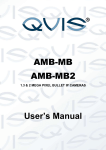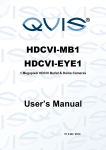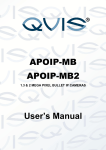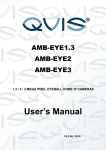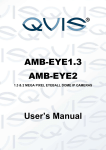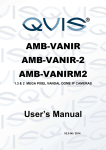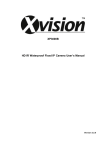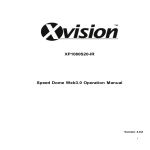Download F Series Indoor IP User`s Manua
Transcript
HOMECAM1 HOMECAM1WIF 720P HOME IP CAMERAS User’s Manual i Welcome Thank you for purchasing the 720P Home IP Camera. This user’s manual is designed to be a reference tool for the installation and operation of your system. Here you can find information about the corresponding IP camera’s features and functions, as well as a detailed installation method. Before installation and operation please read the following safeguards and warnings carefully! ii Important Safeguards and Warnings 1.Electrical safety All installation and operation here should conform to your local electrical safety codes. The power supply shall conform to the requirement in the SELV (Safety Extra Low Voltage) and must make sure that the limited power source is rated 12V DC or 24V AC. Please note: Do not connect two power supplying sources to the device at the same time; it may result in device damage! We assume no liability or responsibility for all the fires or electrical shock caused by improper handling or installation. We are not liable for any problems caused by unauthorized modification or attempted repair. 2.Transportation Security Please ensure that the product does not endure heavy stresses, violent vibration or contact with water during transportation, storage and installation. Please use the original packing material (or the material of the same quality) if you need to return it to vendor. 3.Installation Do not apply power to the product before completing installation. Do not put object(s) on the product. Please install a proper power cut-off device during the installation connection. 4.Qualified engineers needed All the examination and repair work should be done by the qualified service engineers. We are not liable for any problems caused by unauthorised modifications or attempted repair. 5. Environment This product should be installed in a cool, dry place away from direct sunlight, inflammable, explosive substances and etc. Please keep it away from environments that contain electromagnetic radiation or objects that produce it. Please keep sound ventilation around the device at all times. Do not allow the water and other liquid to penetrate into the device if casing has been compromised. This series product complies with the IP66 standard specified in the Degrees of Protection Provided by Enclosure. Ensure lightning surge protection is in place to make sure you fully protect camera circuitry from electrical overload. iii Please make sure the CCD (CMOS) component is away from the radiation of the laser beam device. Otherwise it may result in CCD (CMOS) optical component damage. It is recommended that the grounding studs of the product should be grounded, so to further enhance the reliability of the camera. 6. Daily Maintenance Please shut down the device and then unplug the power cable before you begin any maintenance work. Do not touch the CCD (CMOS) optic component. Please use an air jet to clean the dust off the lens surface. You can use the dry cloth with some alcohol or mild detergent to clear if necessary. When the camera is not in use please put the dustproof cap to protect the CCD (CMOS) component. Do not use volatile solvent such as the benzene, paint thinner or detergent with the ability to abrade surfaces. It may result in lens damage or adversely affect the device’s performance. 7. Accessories Always use all the accessories recommended by manufacturer. Before installation, please open the package and check that all the components are included. Contact your local retailer/vendor ASAP if something is missing. 8. Box Contents: Accessory Name Amount Network Camera Unit 1 User’s Manual 1 Installation Accessories Bag 1 CD 1 iv Table of Contents 1 General Introduction ...................................................................................................... 1 1.1 Overview ........................................................................................................... 1 1.2 Features ............................................................................................................ 1 1.3 Specifications .................................................................................................... 2 1.3.1 Performance ............................................................................................... 2 1.3.2 Factory Default Setup ................................................................................. 4 2 Framework................................................................................................................... 11 2.1 Device Components ........................................................................................ 11 2.2 Dimensions ..................................................................................................... 13 2.3 Bidirectional talk .............................................................................................. 14 2.3.1 Device-end to PC-end............................................................................... 14 2.3.2 PC-end to the Device-end......................................................................... 14 2.4 Alarm Setup .................................................................................................... 15 2.4.1 Alarm Input and Output Connection .......................................................... 15 3 Device Installation ....................................................................................................... 17 4 Quick Configuration Tool ............................................................................................. 19 5 6 4.1 Overview ......................................................................................................... 19 4.2 Operation ........................................................................................................ 19 Web Operation ............................................................................................................ 22 5.1 Network Connection ........................................................................................ 22 5.2 Login and Logout ............................................................................................ 22 FAQ ............................................................................................................................. 25 v 1 General Introduction 1.1 Overview This network camera integrates traditional camera and network video technology. It adopts both audio and video data collection and transmission simultaneously. Because of inbuilt internal hardware it can connect to a network directly without any auxiliary device. When you want to access the camera, you can use a web browser running off the network at the client-end. Due to its multiple functions it allows for various use in many environments such office, bank, road & traffic monitoring, etc. This series network camera product uses the latest industry standard H.264 video and G.711a audio compression technology, which guarantee the best audio and video quality whilst reducing file sizes. One of the other main features this camera includes is the IR night vision, which aids in video surveillance when the camera is functioning within a low illumination environment. The LED IRs highlight objects of interest within the camera’s field of view and is then able to filter out any visual interference so that you can easily view footage upon a monitor. It supports real-time monitor and listening at the same time via the inbuilt microphone. If you want to communicate with a person(s) in view of the camera it also supports dualway bidirectional talk. The built-in protection enclosure and waterproof design conforms to the IP 66 level. It has the sound waterproof function suitable for use in the outdoor environments. 1.2 Features User Management Data Transmission Storage Function Network Monitor Alarm Function Different user rights for each group, one user belongs to one group. The user’s right shall not exceed the group right. Wired network data transmission via the Ethernet port. Wireless Home camera supports WIFI/3G wireless network data transmission. Supports: Central server backup function in accordance with your configuration and setup in alarm or schedule setting Recording via the Web and sending the recorded file to the storage at the client-end’s PC. Micro SD card storage for alarm recording or snapshot storage. Network storage function such as FTP. Network camera supports one-channel audio/video data transmission to network terminal and then decodes signal. Delay is within 270ms (network bandwidth support needed) Supports a maximum of 20 connections. Adopts the following audio and video transmission protocols: HTTP, TCP, UDP, MULTICAST, RTP/RTCP, RTSP, etc. Supports web access. Real-time response to external on-off alarm input. User can setup prerecord time length before alarm trigger incident ( also allows user to pre-record audio file) Real-time video detect: motion detect, camera masking, PIR human body movement detect. © Copyright Qvis ®. All documentation rights reserved. 1 Network Management Power Assistant Function Allows network camera configuration and management via Ethernet. Supports device management via web or client-end. External power adapter DC12V. Power over Ethernet (PoE). Conforms to the IEEE802.3af standard. Connect the device to the switch or the router that supports the PoE function to obtain operational power. Warning! Do not connect these two power supplying sources to the device at the same time; it may result in device damage! Please note: system cannot support these two types of power supplying at the same time. As a recommendation, if you wish for your security system to be able to continue to run when there is a loss of power or unstable electrical supply coming from the mains, a UPS system should be installed. Log function Supports system resource information and running status real-time display. Day/Night mode auto switch. Supports picture parameter setup such as electronic shutter and gain setup. Supports motion detection. Backlight compensation: screen auto split allows backlight compensation to adjust the brightness. Supports video watermark function to avoid vicious video modification. Built in IR light to aid with night vision function. The enclosure conforms to the IP66 protection testing. It can withstand a variety of weather conditions and outdoor environments. Support dual-stream, ACF. Built-in microphone and speaker. Supports PIR human body movement detection. Supports white light alarm function. 1.3 Specifications 1.3.1 Performance Please refer to the following sheet for product performance specification: System Model Parameter Main Processor OS System Resources User Interface System Status Image Sensor Pixel Video Parameter Gain Control White Balance BLC Exposure Mode HOMECAM1 HOMECAM1WIF TI Davinci high performance DSP Embedded LINUX Support real-time network monitor, local record, and remote operation at the same time. Remote operation interface such as WEB, DSS, PSS. Bit stream statistics, log, and software version. 1/3-inch CMOS 1280(H)*960(V) Fixed/Auto Manual/Auto On/Off Manual/Auto © Copyright Qvis ®. All documentation rights reserved. 2 PAL: It ranges from 1/3 to 1/10000. NTSC: It ranges from 1/4 to 1/10000. Video Compression Standard H.264/ H.264B/MJPEG Video Rate PAL: Main stream(1280*960@15fps) extra stream(352*288@15fps), Main stream(1280*720@25fps) extra stream(352*288@25fps) NTSC: Main stream(1280*960@15fps) extra stream(352*240@15fps)), Main stream(1280*720@30fps) extra stream(352*240@30fps) Frame Video Bit Rate Video Flip Snapshot Privacy Mask Video Setup Video Information H.264: 56Kbps-6144Kbps MPEG is adjustable and bit rate is adjustable. Support customized setup. Support mirror. Support flip function. Max 1f/s snapshot. File extension name is JPEG. Supports max 4 privacy mask zones Support parameter setup such as bright, contrast. Channel title, time title, motion detect, camera masking. Lens Interface 3.6mm. Fixed focus. Angle of view: 70°(H)*51.5°(V) M12. Lens is the default accessories Audio Bit Stream Dual-way Audio Input/Output Built-in microphone and speaker Lens Audio Audio Bit Rate Audio Compression Standard 8kbps 16bit G.711A/G.711Mu/PCM Video Motion Detect 396 (18*22) detection zones;sensitivity level ranges from 1 to 6 (The 6th level has the highest sensitivity) Activation event: video storage, image snapshot, log, email SMTP function and etc. Camera Masking Sensitivity level ranges from 1 to 6. Each sensitivity level is the percentage of the privacy mask zone. Activation event: alarm device, audio/video storage, image snapshot, log, email SMTP function and etc. Alarm Port 1-channel input and 1-channel output (on-off ) Record and Backup Record Priority Manual>Video detect>Schedule SD Card Storage Storage Management Support Micro SD card hot-swap N et w o r k Wire Network Support display network storage status 1-channel wire Ethernet port, 10/100 Base-T Ethernet © Copyright Qvis ®. All documentation rights reserved. 3 Wireless Network Network Protocol Remote Operation IR light Compensation Light AUX Port PIR Human Body Movement Detect WPS IEEE802.11a/b/g/n , built-in antenna Standard HTTP, TCP/IP, ARP, IGMP, ICMP, RTSP, RTP,UDP, RTCP, SMTP, FTP, DHCP, DNS, DDNS, PPPOE, UPNP, NTP, Bonjour, SNMP. N/A Monitor, system setup, file download, log information, maintenance , upgrade and etc. White light (Max 1W) Auto turn on white light when an alarm is activated. The light can last until the alarm ends. Support compensation light brightness setup via the Web. Max distance 7m under normal room temperature. Support compensation light activation, record at light. Click one button to enable WIFI N/A connection General Parameter DC 12V and PoE Power Power Consumption Working Temperature Working Humidify Dimensions(mm) Weight Installation DC 12V 4W MAX 6W MAX -10℃~+55℃ -10℃~+50℃ 10%~90% 66.6*99.5*131.2 229g(Excluding box) Installation with the bracket. 1.3.2 Factory Default Setup Please refer to the following sheet for factory default setup information: Item Camera Brightness Default Setup HOMECAM1 50 Contrast 50 Saturation 50 Sharpness 50 Anti-flicker Outdoor Exposure Mode Auto Gain Range 0-50 Scene Mode Auto Day/night Mode Auto BLC Off Mirror Off Flip Off Conditions Setup Vide o bit stre am Vide o Main Stream Bit stream type General Encode mode H.264 © Copyright Qvis ®. All documentation rights reserved. HOMECAM1WIFI 4 Setup Resolution Default Setup HOMECAM1 720P(1280*720) Frame Rate (FPS) PAL: 25 NTSC:30 Bit Rate Type CBR Recommended Bit 1536-6144 Kb/S Bit Rate 4096 Frame Interval 50 Watermark Enable Watermark character DigitalCCTV Enable Enable Bit stream type General Encode mode H.264B Resolution CIF(352*288/352*240) Frame Rate (FPS) PAL: 25 NTSC:30 Bit Rate Type CBR Recommended Bit 192-1024Kb/S Bit Rate 1024 Frame Interval 50 Item Sub Stream Snapshot Video Overlay Path Snapshot Type General Image Size 720P(1280*720) Quality 5 Interval 1s Privacy Mask Disable Channel Title Enable Time Title Enable HOMECAM1WIFI Audio C:\PictureDownload Record Path C:\RecordDownload Enable Enable Encode Mode G.711A Enable Disable Host Name IPC Ethernet Card Wire(default) Mode Static Mac Address Device MAC address when it is shipped out of the factory Main Stream Extra Stream Network Snapshot Path TCP/IP © Copyright Qvis ®. All documentation rights reserved. 5 Setup IP Version Default Setup HOMECAM1 IPV4 IP Address 192.168.1.108 Subnet Mask 255.255.255.0 Default Gateway 192.168.1.1 Preferred DNS 8.8.8.8 Alternate DNS 8.8.8.8 Enable ARP/Ping set device IP address service Enable Max Connection 10 TCP Port 37777 UDP Port 37778 HTTP Port 80 RTSP Port 554 HTTPs Enable Disable HTTPs Port 443 Enable Disable Username none Password N/A Server Type Disable,CN99 DDNS Server IP none Server Port 80 Domain Name none User none Password **** Update Period 10 minutes Trusted sites Disable SMTP Server none Port 25 Anonymity Disable User Name anonymity Password **** Sender none Authentication (Encryption N/A Item Connection PPPoE DDNS IP Filter SMTP(Email) © Copyright Qvis ®. All documentation rights reserved. HOMECAM1WIFI 6 Setup Default Setup HOMECAM1 Item HOMECAM1WIFI mode) UPnP SNMP Bonjour Multicast Title (Subject) IPC Message Attachment N/A Mail Receiver 0 second Email Test Disable,interval=60 seconds Enable UPnP Enable SNMP Port 161 Read Community public Write Community private Trap Address N/A Trap Port 162 SNMP Version SNMP v1:Disable SNMP v2:Disable SNMP v3:Disable Enable Enable Server Name “SN”. It depends on the device. Multicast Address 239.255.42.42 Port 36666 WIFI N/A WIFI WPS QoS Video detect Event Motion Detect N/A Real-time Monitor 0 Command 0 Enable Wireless QoS Disable Enable Disable Anti-dither 5 seconds Sensitivity 3 Compensation Light Disable Compensation Light Delay 10 seconds © Copyright Qvis ®. All documentation rights reserved. Disable PIN Enable PIN Null SSID Null Button Disable 7 Setup Default Setup HOMECAM1 Item Video Masking Alarm PIR Alarm Alarm Activation HOMECAM1WIFI Record Channel Enable Record Delay 10 seconds Relay out Enable Enable Alarm Delay 10 seconds 10 seconds Send Email Disable Snapshot Disable Enable Disable Record Channel Enable Record Delay 10 seconds Relay out Enable Enable Alarm Delay 10 seconds 10 seconds Send Email Disable Snapshot Disable Enable Disable Anti-dither 0 second Compensation Light Enable Compensation Light Delay 10 seconds Record Channel Enable Record Delay 10 seconds Relay out Enable Enable Alarm Delay 10 seconds 10 seconds Send Email Disable Snapshot Disable Enable Disable Relay in Alarm 1 Anti-dither 0 second Sensor Type NO Compensation Light Disable Compensation Light Delay 10 seconds Record Channel Enable Record Delay Enable Relay out 10 seconds Alarm Delay 10 seconds © Copyright Qvis ®. All documentation rights reserved. 8 Setup Item Send Email Snapshot Compensa tion Light Abnormity No SD Card Capacity Warning SD Card Error Disconnect ion IP Conflict Storage Storage Storage Position FTP HOMECAM1WIFI Disable Enable Disable Period All Week Period: 00:00:00-23:59:59. Enable Disable Relay out Enable Relay out Delay 10 seconds Send email Disable Enable Disable Capacity Limit 10% Relay out Enable Relay out Delay 10 seconds Enable Disable Relay out Enable Relay out Delay 10 seconds Send email Disable Enable Disable Record Enable Record Delay 10 seconds Relay out Enable Relay out Delay 10 seconds Enable Disable Record Enable Record Delay Enable Relay out 10 seconds Relay out Delay 10 seconds Local Storage Enable FTP Disable Enable FTP Disable Server IP N/A Port 21 Username anonymous Password N/A Remote path Record Control Default Setup HOMECAM1 Disable Share Emergency Storage (Local) Disable Pack Duration 8 minutes © Copyright Qvis ®. All documentation rights reserved. 9 Setup Pre-record Default Setup HOMECAM1 5 seconds Disk Full Overwrite Record Mode Auto Item Record Stream General System Local Host Date time Auto Maintenance and Bit HOMECAM1WIFI Main Stream Device No Device factory SN Language English Video Standard NTSC Date Format Y-M-D Time Format 24H Time Zone GMT+08:00 System Time Sync DST Disable DST Type Week Start Time 00:00:00 of the first Sunday of the month End Time 00:00:00 of the second Monday of the month NTP Disable NTP Server clock.isc.org Port 37 Update Period 10 minutes Auto Reboot Enable. 02:00 Tuesday Auto Delete Old Files Disable © Copyright Qvis ®. All documentation rights reserved. 10 2 Framework 2.1 Device Components You can refer to the following figure for component information (see Figure 2-1). Figure 2-1 Please refer to the following sheet for detailed information. SN 1 Port Name Power light indicator Indicator POWER Connector Note When system boots up–Green light turns on. When system is upgrading – Green light flashes. Interval is 0.5s. When system is alarming– Green light flashes. Interval is 0.2s. Wire network connection - Red light is on. Wireless network connection Green light is on. / Network indicator light NET 3 Speaker / / Output audio signal. 4 White light / / Activates motion detection, PIR human body movement detection and external alarm. 2 / © Copyright Qvis ®. All documentation rights reserved. 11 SN Port Name Indicator Connector Note Passive IR motion detection port. It can detect the IR object movement (such as human body or other heating object). 5 PIR sensor PIR / 6 Microphone / / 7 Micro SD card Micro SD Micro SD card slot Directly receive audio signal. (This function is optional. For some series product only.). SD card storage. (This function is optional. For some series product only.). Restore factory default setup. When system is running normally, press the RESET button for at least 5 seconds. The system will restore factory default setup. 8 Reset button 9 WPS button (HOMECAM1WIFI model only) WPS Fast wireless connection Press the WPS button of the router and the device for at least 2 seconds. Usually the device can connect to the router within 1 minute. 10 Alarm pin / I/O port Alarm signal input/output 11 Power port DC12V / Input DC 12V power. Reset / 12 Network port LAN Ethernet port cable. © Copyright Qvis ®. All documentation rights reserved. Connect to standard Ethernet Supports PoE function. 12 2.2 Dimensions Please refer to the following figure for dimension information. The unit is mm (see Figure 2-2). Figure 2-2 © Copyright Qvis ®. All documentation rights reserved. 13 2.3 Bidirectional talk 2.3.1 Device-end to PC-end Device Connection 1. Please connect the speaker or the MIC to the audio input port found in the device rear panel. Then connect the earphone to the audio output port in the PC. 2. Login to the Internet and then click the Audio button to enable the bidirectional talk function. 3. You will see that the button becomes orange after you enabled the audio talk function. 4. Click Audio button again to stop the bidirectional talk function. Listening Operation You will be able to listen to any audio coming from the device end by plugging in speakers or a headphone in to the audio output port at the PC end. 2.3.2 PC-end to the Device-end Device Connection 1. Connect the speaker or the MIC to the audio input port in the PC and then connect the earphone to the audio output port of the device. 2. Login to the Web and then click the Audio button to enable the bidirectional talk function. 3. You will see that the button becomes orange after you enabled the audio talk function. 4. Click Audio button again to stop the bidirectional talk function. Listening Operation Speak or play music at the PC-end, you can use the built-in speaker of the device-end to listen. Note: Please go to the Master Volume interface of the PC to set it first if you want to use the dual-way bidirectional talk. Please select Front MIC mode in the record control interface. (You can select microphone enhanced in ‘Advanced’ interface if the audio is too low.) © Copyright Qvis ®. All documentation rights reserved. 14 2.4 Alarm Setup The alarm setup interface is shown as below (see Figure 2-3). Figure 2-3 2.4.1 Alarm Input and Output Connection Please refer to the following figure for alarm input information. See Figure 2-4. Alarm input: When the input signal is idle or grounded, the device can collect the different statuses of the alarm input port. When the input signal is connected to the 3.3V or is idle, the device collects the logic ‘1’. When the input signal is grounded, the device collects the logic ‘0’. Figure 2-4 Please refer to the following figure for alarm output information (see Figure 2-5). Port NO and Port C comprises of an on-off button to provide the alarm output. This button is normally open. The button turns off when there is an alarm output. © Copyright Qvis ®. All documentation rights reserved. 15 Figure 2-5 © Copyright Qvis ®. All documentation rights reserved. 16 3 Device Installation This series camera support two installation modes: wall mount and pendant mount. See Figure 3-1 and Figure 3-2. Important: Please make sure the installation surface can support a minimum of 3X weight of the camera and the bracket. Step 1: Paste the installation positioning map on the installation surface such as wall, ceiling or a wooden board. Step 2: Dig holes in the installation surface according to the installation positioning map. Figure 3-1 Step 3: Insert the expansion bolts, from the accessories bag, to the holes you have just dug out. If it is the wood surface you can skip to the next step. Step 4: Use the screws from the accessories bag to secure the device firmly. Step 5 Connect the cable and then boot up the device. © Copyright Qvis ®. All documentation rights reserved. 17 Step 6: Loosen the adjustable knob a small amount, and then adjust the camera to the desired/proper surveillance position according to your actual requirements. Step 7: Secure the knob of the bracket to fix the camera. Figure 3-2 NUMBER KEY 1 2 3 4 5 6 7 ITEM NAME Main IP camera body Adjustment screw Screws Mounting plate Screw Bolts Positioning Map Installation Surface © Copyright Qvis ®. All documentation rights reserved. 18 4 Quick Configuration Tool 4.1 Overview Quick configuration tool can search current IP address and modify IP address. At the same time, you can use it to upgrade the device. Please note: the tool only applies to the IP addresses in the same segment. 4.2 Operation Double click the ‘ConfigTools.exe’ icon and you will see an interface just like the one shown as in Figure 4-1. In the device list interface, you can view the device’s IP address, port number, subnet mask, default gateway, MAC address, etc. Figure 4-1 Search interface Select one IP address and then right click mouse, you will see an interface like the one shown in Figure 4-2. Note: You can set the IP address, subnet mask and gateway for the network camera & PC. The network camera IP address and PC IP address should be in the same network segment if there is no router. Network camera default IP address is 192.168.1.108. If there is a router, please set the corresponding gateway and subnet mask. The factory default user name is admin and password is admin. For security reasons, please modify your password after you first login. For detailed WEB operation, please refer to the Network Camera Web Operation Manual in the resource CD. © Copyright Qvis ®. All documentation rights reserved. 19 Figure 4-2 Search interface 2 Select the ‘Open Device Web’ item; you can go to the corresponding web login interface (see Figure 4-3). Figure 4-3 Web login If you want to modify the device IP address without logging in to the device web interface, you can go to the configuration tool’s main interface to set. In the configuration tool’s search interface (Figure 4-1), please select a device IP address and then double click it to open the login interface. Or you can select an IP address and then click the Login button to go to the login interface. See Figure 4-4. In Figure 4-4, you can view device IP address, user name, password and port. Please modify the corresponding information to login. © Copyright Qvis ®. All documentation rights reserved. 20 Please note the port information here shall be identical with the port value you set in TCP port in Web Network interface. Otherwise, you cannot login the device. If you are using device background upgrade port 3800 to login, other setups are all invalid. Figure 4-4 Login prompt After you logged in, the configuration tool main interface is shown as below. See Figure 4-5. Figure 4-5 Main interface For detailed information and operation instructions of the quick configuration tool, please refer to the Quick Configuration Tool User’s Manual included in the resources CD. © Copyright Qvis ®. All documentation rights reserved. 21 5 Web Operation This IP camera product supports the Web access and management using a PC. Web includes several modules: monitor channel preview, system configuration, alarm, etc. 5.1 Network Connection Please follow the steps listed below for network connection: Make sure the network camera has connected to the network properly. Please set the IP address, subnet mask and gateway of the PC and the network camera respectively. Network camera default IP address is 192.168.1.108. Subnet mask is 255.255.255.0. Gateway is 192.168.1.1 Use order ping ***.***.***.***(* network camera address) to check connection is OK or not. 5.2 Login and Logout 1. Open web browser and input network camera address in the address bar. For example, if your camera IP is 192.168.1.108, then please input http:// 192.168.1.108 into the web browser’s address bar. See Figure 5-1. Input your IP address here Figure 5-1 IP address 2. The login interface is shown as below. See Figure 5-2. 3. Please input your user name and password. 4. Default factory name is admin and password is admin. Note: For security reasons, please modify your password after you first login. © Copyright Qvis ®. All documentation rights reserved. 22 Figure 5-2 Web login If it is your first time logging in, the system pops up warning information to ask you whether to install the control ‘webrec.cab’ or not, after you have logged in for one minute. Please click OK button, the system can automatically install the control. When system is upgrading, it can overwrite the previous Web as well. If you can’t download the ActiveX file, please check whether you have installed the plug-in to disable the control download. Or you can lower the web browser’s security level. See Figure 5-3. Figure 5-3 IE security level © Copyright Qvis ®. All documentation rights reserved. 23 After you logged in, you can see the main window. See Figure 5-4: Figure 5-4 Web monitoring window © Copyright Qvis ®. All documentation rights reserved. 24 6 FAQ Bug Solution / Reason I cannot boot up the device or operate it properly. Please click the RESET button for at least five seconds to restore factory default setup. The water has leaked into the camera casing The unauthorised front or rear cap removal many result in water leaking into the camera housing. The glass front cap has sustained heavy a push or strike. The waterproof plug of the rear cap becomes loosen. SD card hot swap Before removing SD card, please stop recording and do not take any snapshots firstly and then wait for at least 15 seconds to remove the SD card. This is to ensure data integrity on the SD card is maintained. Otherwise you could lose all the data! SD card write times Do not set the SD card as the main storage media to store data, on the schedule record file. It may damage the SD card and decrease its operational lifetime. I cannot use PIR function. There are heating sources around the device environment. It may result in a false alarm. The PIR sensitivity becomes much lower when the moving object’s distance is more than 6m away from the sensor. I cannot upgrade the device via network. I cannot login the client-end or the WEB. I cannot play the download file. When network upgrade operation has failed, you can use port 3800 to continue upgrade. The Active X control is blocked. The display card version needs to be DX8.1 or higher. Network connection error occurred. Invalid network setup. Invalid user name or password. There is no player. There is no DX8.1 or higher. For the MEDIA PLAYER, there shall be Div X503Bundle.exe plugin if you play the .AVI file. For Windows XP user, you need to install the plugin DivX503Bundle.exe and ffdsho-2004 1012.exe. To guarantee setup update After you modified the important setup, please reboot the device via the software to make sure the setup has been updated to the storage medium. Power adapter The general power adapter can only work reliably within the temperature range of between 0℃ to 40 ℃. If the power supply is being operated outside this temperature range then it may result in an unstable power supply being provided to the camera. Please replace with an industrial-grade power adapter if you are using it in a harsh environment. © Copyright Qvis ®. All documentation rights reserved. 25 Note This user’s manual is for reference only. Slight differences may be found in user interface. All the designs and software here are subject to change without prior written notice. © Copyright Qvis ®. All documentation rights reserved. 26 For more information about our IP Cameras and other available cameras, NVRs & accessories, please visit our website: www.adata.co.uk Alternatively scan this QR code with your smart phone to be directed instantly to our website: © Copyright Qvis ®. All documentation rights reserved. 27


































